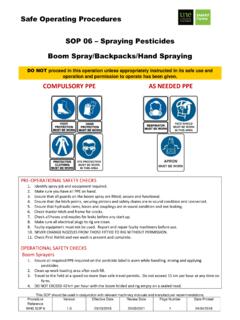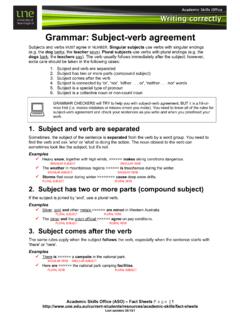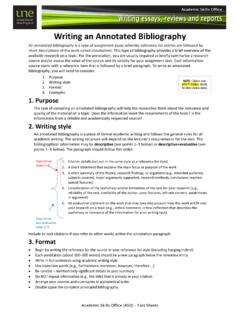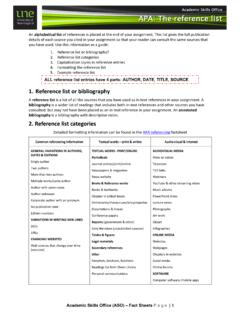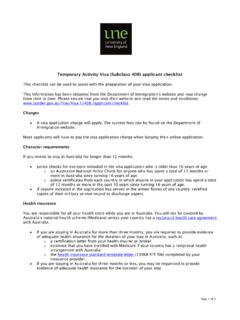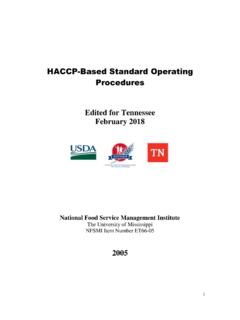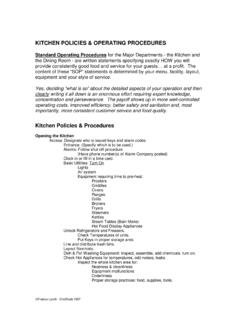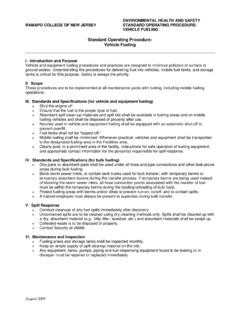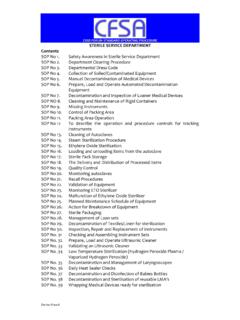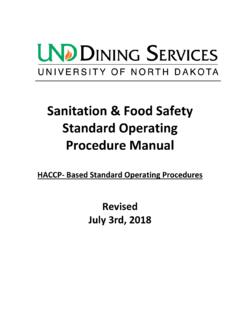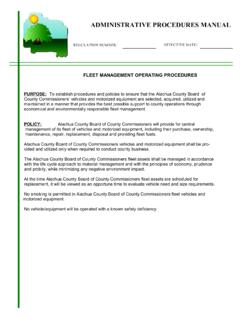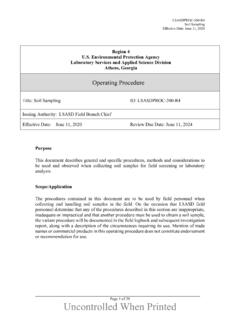Transcription of Safe Operating Procedures SOP 14 Fuelling Vehicles
1 safe Operating Procedures SOP 14 Fuelling Vehicles DO NOT proceed in this operation unless appropriately instructed in its safe use and operation and permission to operate has been given. COMPULSORY PPE AS NEEDED PPE. PRE-OPERATIONAL SAFETY CHECKS. 1. Ensure all guards are fitted, secure and functional. 2. Ensure there is a suitable fire extinguisher within 5 m of the Fuelling area. 3. Identify and ensure you know how to operate emergency fuel cut-off switches and valves 4. Ensure the vehicle engine is turned off before refuelling. 5. Check there are no lit cigarettes, open flames, mobile phones or electronic handheld devices or other sources of spark or static in the vicinity while Fuelling .
2 6. Check the fuel tank placard to ensure you are filling with the correct fuel. 7. Examine all fuel hoses, connections and couplings and make sure there are no leaks. 8. Locate and be familiar with ON/OFF switches, taps and controls. 9. Ensure fuel nozzle is operational before starting the motor and pump. 10. Faulty equipment must not be used. Report suspect machinery immediately. OPERATIONAL SAFETY CHECKS. 1. Remove the filler cap. Avoid dust getting into the fuel tank. 2. Ensure the area is well ventilated when Fuelling Vehicles or equipment. 3. Once started, note the pressure uptake in the fuel hose.
3 4. Immediately report any leaks that are observed. Turn off pump if required. 5. Keep the metal fill nozzle in contact with the lip of the tank to eliminate any static accumulation. 6. Adjust the nozzle trigger to suit the particular fuel flow requirements. 7. Always check the fuel flow at regular intervals during normal operation. 8. Never kink the fuel hose to restrict or cut off the flow of fuel. 9. Report any fuel spills immediately and begin use of spill response/ recovery kit. 10. If fuel splashes onto clothing, remove and allow for fuel to evaporate completely outdoors before washing. Thoroughly wash clothing before re-use.
4 Fuelling WITH A CAN. 1. Use a proper Fuelling nozzle or funnel to avoid splashing fuel on the engine or frame of the equipment. 2. Fill slowly and listen to air coming out of the can as the fuel pours in. As the can nears the full level, air will come out faster, and the pitch will get higher. Stop before the tank is full. Leave 5 percent empty to This SOP should be used in conjunction with relevant machinery manuals and manufacturer recommendations. Procedure Version Effective Date Review Date Page Number Date Printed Reference WHS SOP 14 28/03/2018 28/03/2021 1 24/04/2018. safe Operating Procedures allow for expansion of the tank.
5 3. When the tank is full, let the Fuelling nozzle drain for a few seconds before removing it from the fuel port to prevent dripping. 4. Replace the filler cap. CLEANING UP. 1. Avoid spillage on equipment or ground. If you have a spill, you MUST report to your supervisor or the person in charge. 2. Spills are to be contained immediately. Use peat, oil dry or similar product on small spills. 3. Fuel spilled on hands or exposed skin shall be washed with soap and water as soon as possible, 4. Wipe up any spills or drips and allow any damp spots around the motor to evaporate before attempting to start the equipment.
6 5. Lock up any unattended pump to store portable fuel cans in a well ventilated area away from open flame or sparks. MAITENANCE. 1. Remove any rubbish or foreign material from filling area. 2. Clean the entire area at completion of task. 3. Service pump and equipment as required as per manufacturer's recommendation. 4. Keep the work area clean and tidy. POTENTIAL HAZARDS. 1. Fire and explosion - No smoking, naked flame or ignition sources 2. Absorption - Apron, gloves and safety glasses 3. Inhalation of fumes - Ventilate area 4. Splash injuries - Cut off nozzles, PPE. OTHERS. Code of Practice - Managing Risks of Hazardous Chemicals in the Workplace Code of Practice Australian Standard - AS 1940 Storage and Handling of Flammable and Combustible Chemicals SDS Diesel and ULP available via Chemwatch SPECIAL NOTE.
7 NO PERSONNEL ARE TO USE THIS EQUIPMENT PRIOR TO OBTAINING: COMPETANCY IN THE CORRECT USE OF THE EQUIPMENT. READING THE STANDARD Operating PROCEDURE. UNDERGOING THOROUGH PRACTICAL TRAINING WHILE PROPERLY SUPERVISED. SUPERVISOR TO SIGN OFF SOP. All completed SOPs are to be recorded in TRIM Container A17/2181 utilising a TRIM license in your School/Business Unit. Completed SOPs are to be published on Safety Hub for ongoing utilisation. Employee Name: _____. Employee Signature: _____ Date: _____. Supervisor Name: _____. Supervisor Signature: _____ Date: _____. This SOP should be used in conjunction with relevant machinery manuals and manufacturer recommendations.
8 Procedure Version Effective Date Review Date Page Number Date Printed Reference WHS SOP 14 28/03/2018 28/03/2021 2 24/04/2018.

